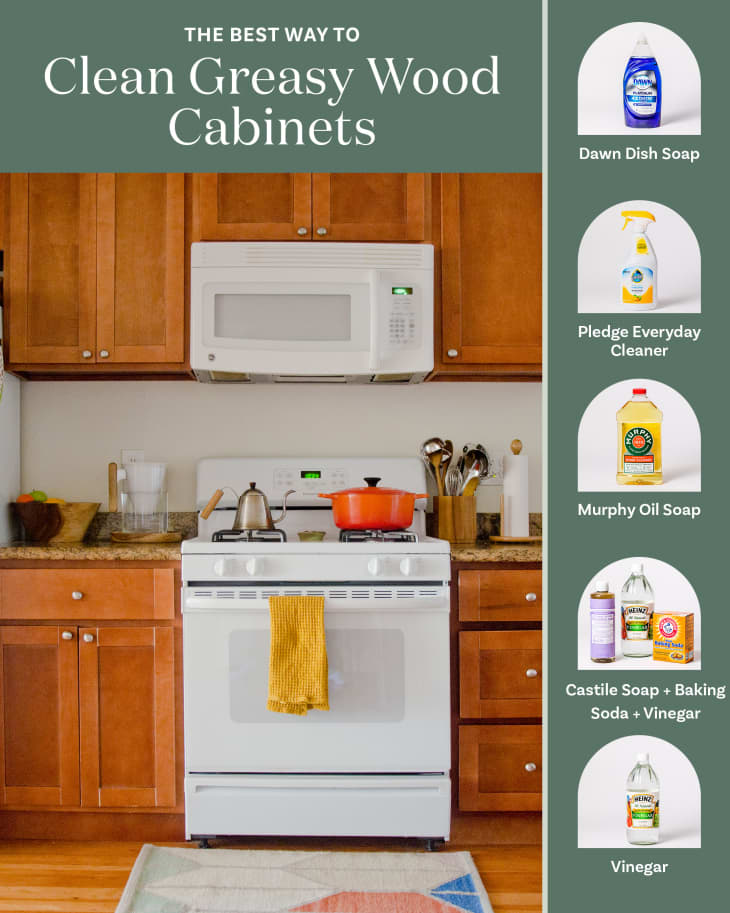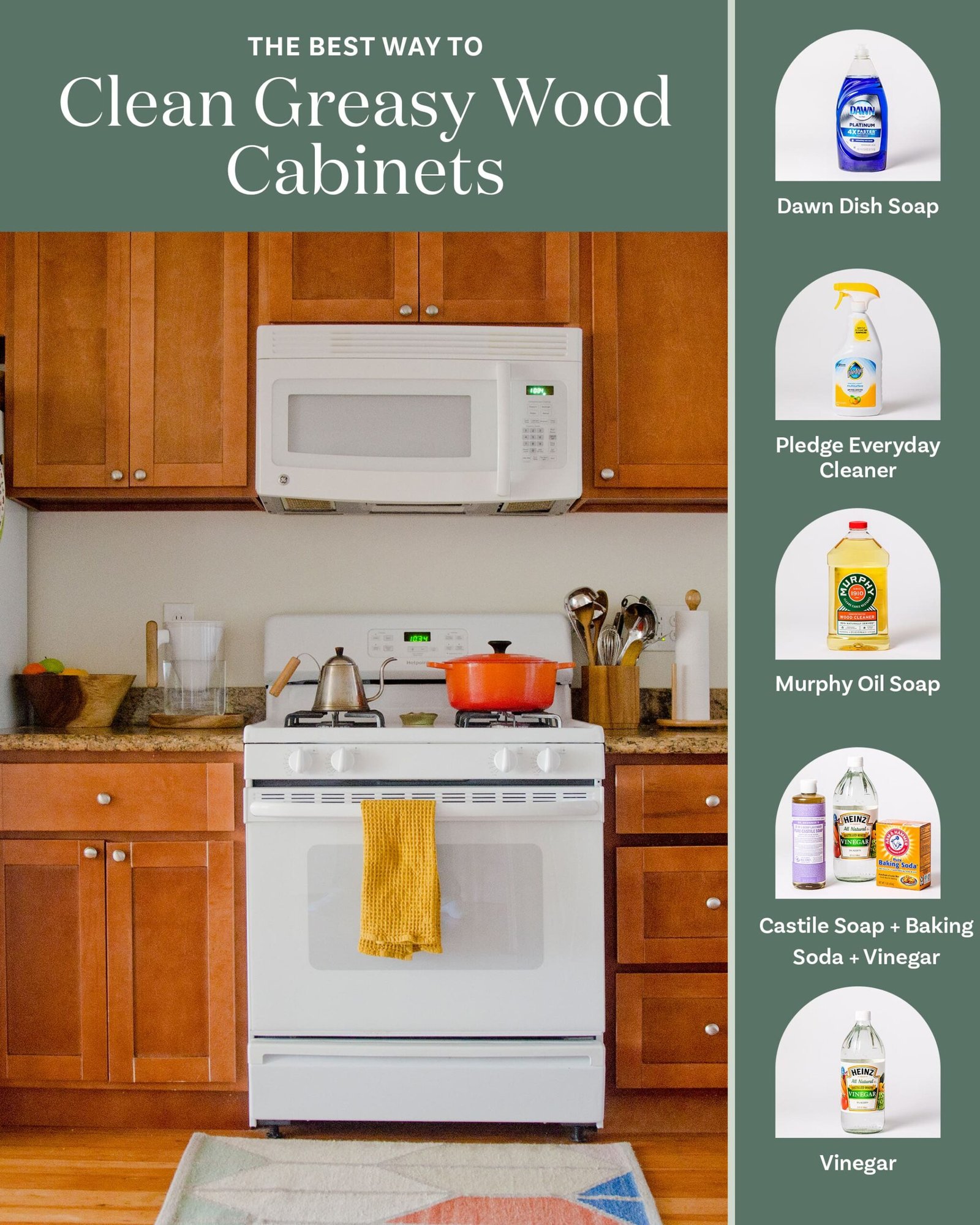The best way to clean kitchen cabinets is to use mild soap and warm water. Wipe with a soft cloth, then dry thoroughly.
Kitchen cabinets can accumulate grease, dust, and food particles over time, making them look dingy. Regular cleaning maintains their appearance and extends their lifespan. Using gentle cleaning solutions prevents damage to the cabinet finish. A soft cloth ensures a scratch-free clean.
Drying immediately after cleaning prevents water damage. This method is effective for both wooden and laminate cabinets. Avoid harsh chemicals that can strip the finish. Consistent care keeps cabinets looking new and well-maintained. Cleaning also ensures a hygienic kitchen environment. Follow these tips for sparkling, spotless cabinets.
:max_bytes(150000):strip_icc()/steps-to-clean-kitchen-cabinets-1900630-final-5bbcde064cedfd0026eeec24.png)
Table of Contents
TogglePreparation
Cleaning kitchen cabinets can be easy with the right preparation. Proper preparation ensures that your cabinets get thoroughly cleaned. Follow these steps to get ready for a deep clean.
Gather Supplies
First, gather all the supplies you need. Having everything ready saves time and effort. Here’s a list of essential supplies:
- Mild dish soap
- Warm water
- Sponges or soft cloths
- Microfiber cloths
- Old toothbrush
- White vinegar
- Baking soda
- Empty spray bottles
- Protective gloves
Place all these items within reach before you start cleaning.
Empty Cabinets
Next, empty the cabinets completely. This allows you to clean every corner and shelf. Follow these steps to empty your cabinets:
- Remove all dishes, pots, and pans.
- Take out food items and spices.
- Place everything on a nearby table or counter.
- Remove shelf liners if you use them.
With empty cabinets, you can easily access every surface for a thorough clean.
Choosing Cleaning Products
Cleaning kitchen cabinets can seem overwhelming. The right cleaning products make a huge difference. You must choose wisely to avoid damaging your cabinets. Here are some tips on selecting the best cleaning products.
Natural Cleaners
Natural cleaners are safe for your family and the environment. Vinegar and water is a simple, effective solution. Mix equal parts in a spray bottle.
Baking soda is great for tough stains. Make a paste with water and apply it to the stain. Let it sit for a few minutes before scrubbing gently.
Lemon juice can help remove grease. Mix it with water for a fresh-smelling cleaner.
Here’s a quick table for easy reference:
| Natural Cleaner | Usage |
|---|---|
| Vinegar and Water | General cleaning |
| Baking Soda | Stain removal |
| Lemon Juice | Grease removal |
Commercial Options
Commercial cleaners are designed for specific tasks. All-purpose cleaners can handle most dirt and grime. Check the label to ensure it’s safe for your cabinet material.
Degreasers are excellent for kitchens. They cut through grease easily. Always follow the instructions for best results.
Wood cleaners are perfect for wooden cabinets. They clean and protect the wood. Use a soft cloth to apply and buff.
Here’s a quick list of some commercial options:
- All-purpose cleaners
- Degreasers
- Wood cleaners
Cleaning Techniques
Keeping your kitchen cabinets clean is vital for a healthy home. Using the right cleaning techniques can make this task easier and more effective. Below are some methods to help you maintain spotless cabinets.
Dusting And Wiping
Dusting and wiping are essential for daily maintenance. Use a soft cloth or a microfiber duster to remove loose dust and dirt. Follow these steps to dust and wipe your cabinets:
- Start by removing all items from the cabinets.
- Use a dry cloth to dust off the surface.
- Mix warm water with a few drops of dish soap.
- Dip a sponge or cloth in the soapy water.
- Wipe the cabinet surfaces gently.
- Rinse with a damp cloth to remove soap residue.
- Dry with a clean towel to prevent water spots.
Deep Cleaning
Deep cleaning is crucial for removing tough stains and grease. This should be done monthly or as needed. Here is a step-by-step guide for deep cleaning your kitchen cabinets:
- Empty the cabinets and remove any shelf liners.
- Mix a solution of vinegar and warm water in a spray bottle.
- Spray the solution onto the cabinet surfaces.
- Let it sit for 5-10 minutes to break down grease.
- Scrub with a soft brush or sponge.
- Rinse with a damp cloth to remove the vinegar solution.
- Dry thoroughly with a clean towel.
| Cleaning Method | Frequency | Materials Needed |
|---|---|---|
| Dusting and Wiping | Weekly | Microfiber cloth, dish soap, sponge |
| Deep Cleaning | Monthly | Vinegar, water, spray bottle, brush |

Handling Stubborn Stains
Cleaning kitchen cabinets can be challenging, especially with stubborn stains. Grease and sticky residues often require special attention. This guide will help you tackle these tough spots with ease.
Grease Removal
Grease can build up quickly on kitchen cabinets. Removing grease effectively is crucial for maintaining cleanliness.
Here’s a simple method:
- Mix one part vinegar with two parts warm water.
- Add a few drops of dish soap to the mixture.
- Dip a soft cloth in the solution.
- Wipe the greasy areas gently.
- Rinse with clean water and dry with a towel.
If the grease persists, sprinkle baking soda on a damp sponge. Scrub the area gently, then rinse and dry.
Sticky Residues
Sticky residues can make cabinets look dirty. Removing sticky residues requires a bit more effort but is manageable.
Follow these steps:
- Mix equal parts baking soda and water to form a paste.
- Apply the paste to the sticky area.
- Let it sit for 10-15 minutes.
- Scrub the area with a soft brush or cloth.
- Rinse with water and dry with a clean towel.
If the stickiness remains, try using a small amount of rubbing alcohol on a cloth. Rub the area gently, then rinse and dry.
Cleaning Different Materials
Kitchen cabinets come in various materials, each requiring special care. Understanding how to clean these materials ensures they remain in great condition. Below, find tips for cleaning different types of kitchen cabinets.
Wood Cabinets
Wood cabinets bring warmth and elegance to your kitchen. To keep them looking new, follow these steps:
- Dust Regularly: Use a soft cloth to remove dust.
- Mix Vinegar and Water: Combine equal parts in a spray bottle.
- Spray and Wipe: Lightly spray the solution and wipe with a soft cloth.
- Dry Immediately: Use a dry cloth to avoid water damage.
For tough stains, create a paste with baking soda and water. Apply the paste, then gently scrub with a sponge. Remember to dry the area thoroughly to prevent moisture damage.
Laminate Cabinets
Laminate cabinets are durable and easy to maintain. Follow these steps for a spotless finish:
- Dust First: Use a microfiber cloth to remove surface dust.
- Use Mild Detergent: Mix a few drops with warm water.
- Wipe Cabinets: Dip a soft cloth in the solution and wipe down.
- Rinse and Dry: Use a clean cloth with plain water, then dry completely.
For stubborn stains, a paste of baking soda and water can be used. Apply the paste, let it sit for a few minutes, then gently scrub and rinse.
Ensure you avoid abrasive cleaners that can scratch the laminate surface. Regular cleaning keeps your cabinets looking fresh and new.
Maintaining Cabinet Hardware
Maintaining cabinet hardware is crucial for a clean and functional kitchen. Regular care ensures that handles, knobs, hinges, and tracks work efficiently. It also keeps your kitchen looking fresh and stylish.
Handles And Knobs
Handles and knobs can collect dirt and grime quickly. Wipe them down with a damp cloth. Use mild soap if necessary. Avoid harsh chemicals that can damage the finish.
For stubborn stains, mix baking soda and water. Apply the paste to the stain. Let it sit for a few minutes. Wipe it off with a clean, damp cloth. Buff dry with a soft towel.
Check for loose screws regularly. Tighten them to avoid wobbly handles. Replace any damaged knobs or handles promptly.
Hinges And Tracks
Hinges and tracks help your cabinet doors open and close smoothly. Clean them with a soft brush to remove dust. Use a damp cloth for more stubborn dirt.
Apply a light coat of lubricant to the hinges. This prevents squeaking and ensures smooth operation. Wipe away any excess lubricant with a cloth.
For tracks, vacuum to remove debris. Then, wipe with a damp cloth. Apply a small amount of lubricant if the tracks feel sticky.
Check for loose screws or misalignment. Adjust or tighten as needed to keep everything functioning well.
| Hardware | Cleaning Method | Maintenance Tips |
|---|---|---|
| Handles and Knobs | Wipe with damp cloth, use mild soap | Tighten screws, replace damaged parts |
| Hinges and Tracks | Brush off dust, wipe with damp cloth | Lubricate, check for loose screws |
Preventive Measures
Keeping your kitchen cabinets clean is easier with preventive measures. Regular care prevents grime build-up and prolongs their life. Explore these tips to maintain your cabinets.
Regular Maintenance
Regular maintenance is key to clean kitchen cabinets. Wipe down surfaces daily with a soft cloth. Weekly, use a mild cleaner to remove grease.
Monthly, check for spills and stains. Use a gentle scrub to clean stubborn spots. Keep the cabinet interiors tidy. Organize items to prevent clutter and dust.
| Frequency | Task |
|---|---|
| Daily | Wipe down surfaces |
| Weekly | Use a mild cleaner |
| Monthly | Deep clean and organize |
Protective Coatings
Protective coatings add a layer of defense to your cabinets. Use a wax finish or polyurethane coating to shield surfaces.
- Wax finish: Apply every six months.
- Polyurethane: Apply yearly for best results.
These coatings repel water and resist stains. They also make cleaning easier. Ensure the cabinets are dry before application. Use a soft cloth for even coverage.

Expert Recommendations
Cleaning kitchen cabinets can be tricky. Experts have shared their best tips to make it easier. Learn the most effective and safe ways to keep your cabinets spotless.
Common Mistakes
Many people make some common mistakes while cleaning kitchen cabinets. Avoiding these can save time and effort.
- Using Harsh Chemicals: Strong cleaners can damage the finish. Use mild soap and water instead.
- Ignoring the Handles: Handles often have the most grime. Clean them thoroughly.
- Skipping Regular Cleanings: Dirt builds up quickly. Clean cabinets weekly to prevent tough stains.
- Using Abrasive Scrubbers: These can scratch the surface. Use soft cloths or sponges.
Pro Tips
Experts have shared some pro tips for cleaning kitchen cabinets efficiently. These tips can help you achieve the best results.
- Test Cleaners: Test any cleaner on a small hidden area first.
- Use Natural Cleaners: Vinegar and baking soda are safe and effective.
- Wipe Dry: Always dry the cabinets after cleaning to prevent water damage.
- Organize: Keep items organized to reduce spills and stains.
| Task | Recommended Frequency |
|---|---|
| Dusting | Weekly |
| Deep Cleaning | Monthly |
| Handle Cleaning | Weekly |
Frequently Asked Questions
How Often Should I Clean Kitchen Cabinets?
Clean kitchen cabinets every few weeks to prevent buildup of grease, dirt, and food particles.
What Is The Best Cleaner For Wood Cabinets?
Use a mixture of mild dish soap and warm water. Avoid harsh chemicals to prevent damage.
Can Vinegar Clean Kitchen Cabinets?
Yes, vinegar mixed with water can effectively clean and disinfect kitchen cabinets.
How Do I Remove Grease From Cabinets?
Use a mix of baking soda and water. Scrub gently to remove grease without damaging the surface.
Are There Natural Cleaners For Kitchen Cabinets?
Yes, ingredients like vinegar, baking soda, and lemon juice are effective natural cleaners for cabinets.
Can I Use Bleach On Kitchen Cabinets?
Avoid using bleach. It can damage the finish and discolor the wood or paint.
What’s The Best Way To Clean Cabinet Handles?
Wipe handles with a cloth soaked in soapy water. Rinse and dry thoroughly to prevent rust and residue.
How Do I Prevent Cabinet Stains?
Wipe spills immediately. Use cabinet liners to protect surfaces from stains and spills.
Can I Use A Steam Cleaner On Cabinets?
Steam cleaners can warp wood and damage finishes. Stick to gentle, non-abrasive cleaning methods.
How Do I Clean Painted Kitchen Cabinets?
Use a soft cloth with mild soap and water. Avoid abrasive sponges that can scratch the paint.
Conclusion
Keeping your kitchen cabinets clean is essential for a healthy home. Use gentle cleaners and regular maintenance. Avoid harsh chemicals to preserve the cabinet’s finish. Consistent care ensures longevity and beauty. Follow these tips for sparkling, well-maintained kitchen cabinets. Enjoy a cleaner, more inviting kitchen space every day.


